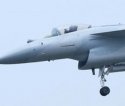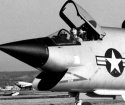Since the J-10 Thread III has over 500 pages, it's time to start a new J-10 IV Thread.
I will start by referring to the Popular Science Article ont he J-10B, and then posting some pictures of the J-10B
Please use the J-10 IV Thread for future J-10 Posts[/b][/color]
For novices, how to tell the difference between a J-10A and a J-10B?
1. Look at the air intake. The front of the "A" intake is separated from the fuselage. The "B: is faired into the fuselage and represents a DVI intake..
2. Look at the nose in front of the cockpit. The "B" has an IRST sensor. The ""A" does not.
3. Look at the tail (vertical stabilizer). The "B" has a segment that is higher than the "A".
4. Not as visible to the untrained eye, but the "B" has a new AESA radar. The nose cone for the Chinese aircraft usually differs in color for different radars.
There are other differences, but those first three (particular the first two) make it wasy to tell them apart
Here are some more pics. I particularly like the 1st one because it shpws 14 J-10Bs parked together...making it apparent IMHP that this aircraft is operational with the PLAAF.
I will start by referring to the Popular Science Article ont he J-10B, and then posting some pictures of the J-10B
Please use the J-10 IV Thread for future J-10 Posts[/b][/color]
Popular Science said:This J-10B prototype, 1035, is installed with an indigenous WS-10B turbofan engine with a the bright silver afterburner nozzle, which makes it a completely Chinese fighter. However, the PLAAF choose to install the J-10B with the Russian AL-31FN III due to slightly higher thrust, lower costs and compatibility with existing J-10A logistics and supply chains.
New pictures have emerged of additional production models of the J-10B “Vigorous Dragon” fighter jets, one of the latest planes to equip China’s growing air force (PLAAF).
There are now J-10Bs painted in operational color scheme of the PLAAF, complete with an extended refueling probe on the right side forward of cockpit.
The J-10B differs from the original J-10A model in several ways: active electronically scanned array (AESA) radar, integrated jamming pods, IRST sensor, diverterless supersonic intake (DSI), and an uprated AL-31FN Series III turbofan engine. These upgrades give the J-10B increased engine power, infrared detection against stealthy aircraft and increased jamming capability against enemy missiles. In particular, the DSI has two advantages over traditional engine intakes: it saves weight and is more stealthy against radar.
The most important upgrade in the J-10B is its AESA radar, which features a longer range, frequency hopping to foil enemy jamming and higher power to track stealth aircraft (such as the US B-2, F-22, and F-35) at long range. The J-10B also possesses a strong multirole capability-- it can carry both 100km ranged PL-12 air to air missiles and LS-500J laser guided bombs on the same mission. These advanced "4.5+ generation" features places the J-10B in the same class as the F-16 Block 60 (flown only by the UAE), French Rafale, and Eurofighter Typhoon.
The 22nd production model of the J-10B, numbered at "122", rolled off the production line in Chengdu.
The "122" serial number indicates that this fighter is the 22nd J-10B fighter to be produced for the PLAAF; the highest production serial number as of the date of this article = is "124".
Since late 2013, Chengdu Aviation Corporation has begun serial production of the J-10B, which had its first flight in 2008.
Compared to all the other J-10s, which have Russian AL-31FN engines, Number 1035 was fitted with a domestic WS-10B turbofan engine. But the WS-10B was not adopted, likely for cost reasons and in order to streamline logistics. This is potentially significant to the international arms trade. A J-10B powered by the WS-10B would be a completely domestic Chinese fighter, thus bypassing any Russian objections J-10B exports, which could compete with the MiG-35 in foreign markets.
For novices, how to tell the difference between a J-10A and a J-10B?
1. Look at the air intake. The front of the "A" intake is separated from the fuselage. The "B: is faired into the fuselage and represents a DVI intake..
2. Look at the nose in front of the cockpit. The "B" has an IRST sensor. The ""A" does not.
3. Look at the tail (vertical stabilizer). The "B" has a segment that is higher than the "A".
4. Not as visible to the untrained eye, but the "B" has a new AESA radar. The nose cone for the Chinese aircraft usually differs in color for different radars.
There are other differences, but those first three (particular the first two) make it wasy to tell them apart
Here are some more pics. I particularly like the 1st one because it shpws 14 J-10Bs parked together...making it apparent IMHP that this aircraft is operational with the PLAAF.
Last edited:








